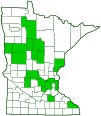Splendid earth-boring beetle
(Geotrupes splendidus)
Conservation • Description • Habitat • Ecology • Distribution • Taxonomy
Conservation Status |
|||
| IUCN Red List | not listed |
||
| NatureServe | NR - Unranked |
||
| Minnesota | not listed |
||
Description
Splendid earth-boring beetle is a medium-sized scarab beetle. It is one of the most common and most widely distributed species in the genus.
Adults are ½″ to ¾″ long and ¼″ to ½″ wide. The body is very stout, oval when viewed from above (dorsally) and strongly convex when viewed from the side (laterally). It is shiny and usually bright metallic green, purple, or bronze, sometimes light blue.
The first segment of the thorax is large and is covered above by a metallic green exoskeletal plate (pronotum). The pronotum is coarsely and unevenly pitted (punctate).
The hardened outer forewings (elytra) are free, not fused; ridged longitudinally (striate); and pitted in rows. The pits are shallow but well developed. The elytral margins are narrowly flared. The innermost grooves (stria), where the elytra meet in the middle, do not extend to the base of the elytra. The color of the stria is the same as the color of the rest of the elytra. There is a small, metallic green, triangular plate (scutellum) between the bases of the wings that is not covered by the elytra. The sides of the scutellum are only slightly curved.
The head is large and is not concealed beneath the pronotum. The antennae are dark reddish-brown and clubbed. They have 11 segments. When viewed from above the base of the antennae are not visible. The last three segments are light reddish-brown and are expanded sideways on one side into long flattened lobes. The antennal lobes can be closed into a tight club or fanned out to detect odors. They are small and both sides are straight, not convex.
The legs are stout and black with a slight bluish or greenish iridescence on the upper surface of the third and largest leg segment (femur). The fourth segment (tibia) of the front leg of the male is enlarged, broad, and adapted for digging. The tibia of the middle and hind legs have a distinct horizontal ridge. The end segment of each leg (tarsus) has 5 sections.
There are two recognized subspecies. G. s. miarophagus is larger, ⅝″ to ¾″ long and ⅜″ to ½″ wide, coppery green to purplish-black, and is found generally west of the Appalachian Mountains. G. s. splendidus is smaller, ½″ to 11 ⁄16″ long and ¼″ to 7 ⁄16″ wide, bright green or occasionally light blue,rarely purplish-black, and is found generally east of the Appalachian Mountains. They are otherwise identical in appearance.
Size
Total length: ½″ to ¾″
Similar Species
Habitat
Ecology
Season
One generation: March to November
Behavior
Life Cycle
In September and October, new male adults emerge about a week before the females. They feed mostly on fungi. During this time, the male creates a burrow 5 to 8 inches deep into the soil under decaying fungi. He provisions it with the decaying fungi, feeds in the burrow, and waits for a female. Copulation takes place inside the burrow. Before or after breeding, a 2½″ to 3½″ long, 1″ in diameter food cell is excavated. The food cell is then tightly packed with concentric layers of pieces of dead leaves. The adult male and female overwinter in the burrow, emerging the following April. From April through June the female deposits yellowish-white eggs in the food cell. The larvae pass through three stages of development (instars) before pupating.
Larva Food/Hosts
Adult Food
The preferred food is fungi, but adults have also been seen feeding on carrion, dung, and feathers.
Distribution |
||
|
Sources Howden, Henry F. (1955). Biology and taxonomy of North American Beetles of the subfamily Geotrupinae with revision of the genera Bolbocerosomas Eucanthus Geotrupes and Peltotrupes. Proceedings of the United States National Museum, 104, 151--319. https://www.biodiversitylibrary.org/part/51039 |
|
| 11/23/2025 | ||
Occurrence |
||
Common and widespread in eastern and midwestern United States |
||
Taxonomy
Order
Coleoptera (Beetles)
Suborder
Polyphaga (Water, Rove, Scarab, Long-horned, Leaf, and Snout Beetles)
Infraorder
Scarabaeiformia
Superfamily
Scarabaeoidea (Scarabs, Stag Beetles, and Allies)
Family
Geotrupidae (Earth-boring Beetles)
Subfamily
Geotrupinae
Tribe
Geotrupini
Genus
Geotrupes
Subgenus
Cnemotrupes
Species epithet
Almost all sources of information for this species refer to this species by the scientific name Geotrupes splendidus. The usually reliable ITIS, originally referred to as Interagency Taxonomic Information System, now just ITIS, lists this species as Geotrupes splendidulus. A very few other sources also use this spelling. It is not known whether this is a misspelling that got picked up by a (very) few authors, or a legitimate synonym. However, Geotrupes splendidulus is never listed as a synonym for Geotrupes splendidus.
Subordinate Taxa
splendid earth-boring beetle (Geotrupes splendidus miarophagus) ![]()
![]()
splendid earth-boring beetle (Geotrupes splendidus splendidus) ![]()
Synonyms
Common Names
earth-boring dung beetle
glossy pillbug
splendid earth borer
splendid earth-boring beetle
Glossary
Elytra
The hardened or leathery forewings of beetles used to protect the fragile hindwings, which are used for flying. Singular: elytron.
Femur
On insects and arachnids, the third, largest, most robust segment of the leg, coming immediately before the tibia. On humans, the thigh bone.
Instar
The developmental stage of arthropods between each molt; in insects, the developmental stage of the larvae or nymph.
Pronotum
The exoskeletal plate on the upper side of the first segment of the thorax of an insect.
Punctate
Dotted with pits (punctures), translucent sunken glands, or colored spots of pigment.
Scutellum
The exoskeletal plate covering the rearward (posterior) part of the middle segment of the thorax in some insects. In Coleoptera, Hemiptera, and Homoptera, the dorsal, often triangular plate behind the pronotum and between the bases of the front wings. In Diptera, the exoskeletal plate between the abdomen and the thorax.
Striate
Striped or grooved in parallel lines (striae).
Tarsus
The last two to five sections of an insect’s leg, attached to the tibia; the foot. Plural: tarsi.
Tibia
The fourth segment of an insect leg, after the femur and before the tarsus (foot). The fifth segment of a spider leg or palp. Plural: tibiae.
Visitor Photos
Share your photo of this insect.
This button not working for you?
Simply email us at info@MinnesotaSeasons.com.
Attach one or more photos and, if you like, a caption.
Babette Kis |
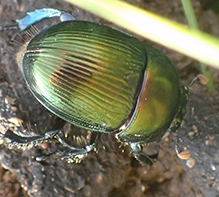 |
Geotrupes splendidus splendid earth-boring beetle Geotrupes splendidus, splendid earth-boring beetle, photographed at Barnes Prairie, Racine Co. WI on Oct. 2, 2023. |
Matt Klocke |
||
5 miles from Dent, MN near Dead Lake |
||
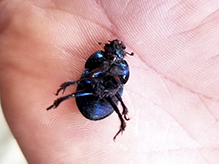 |
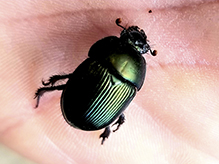 |
|
Sara Brice |
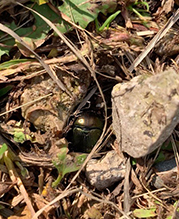 |
Luciearl |
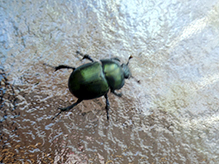 |
MinnesotaSeasons.com Photos
|
|

Slideshows
Splendid Earth Boring Beetle (Geotrupes splendidus)
Andree Reno Sanborn

Visitor Videos
Share your video of this insect.
This button not working for you?
Simply email us at info@MinnesotaSeasons.com.
Attach a video, a YouTube link, or a cloud storage link.
Other Videos

Visitor Sightings
Report a sighting of this insect.
This button not working for you?
Simply email us at info@MinnesotaSeasons.com.
Be sure to include a location.
Babette Kis
10/2/2023
Minnesota Seasons Sightings

